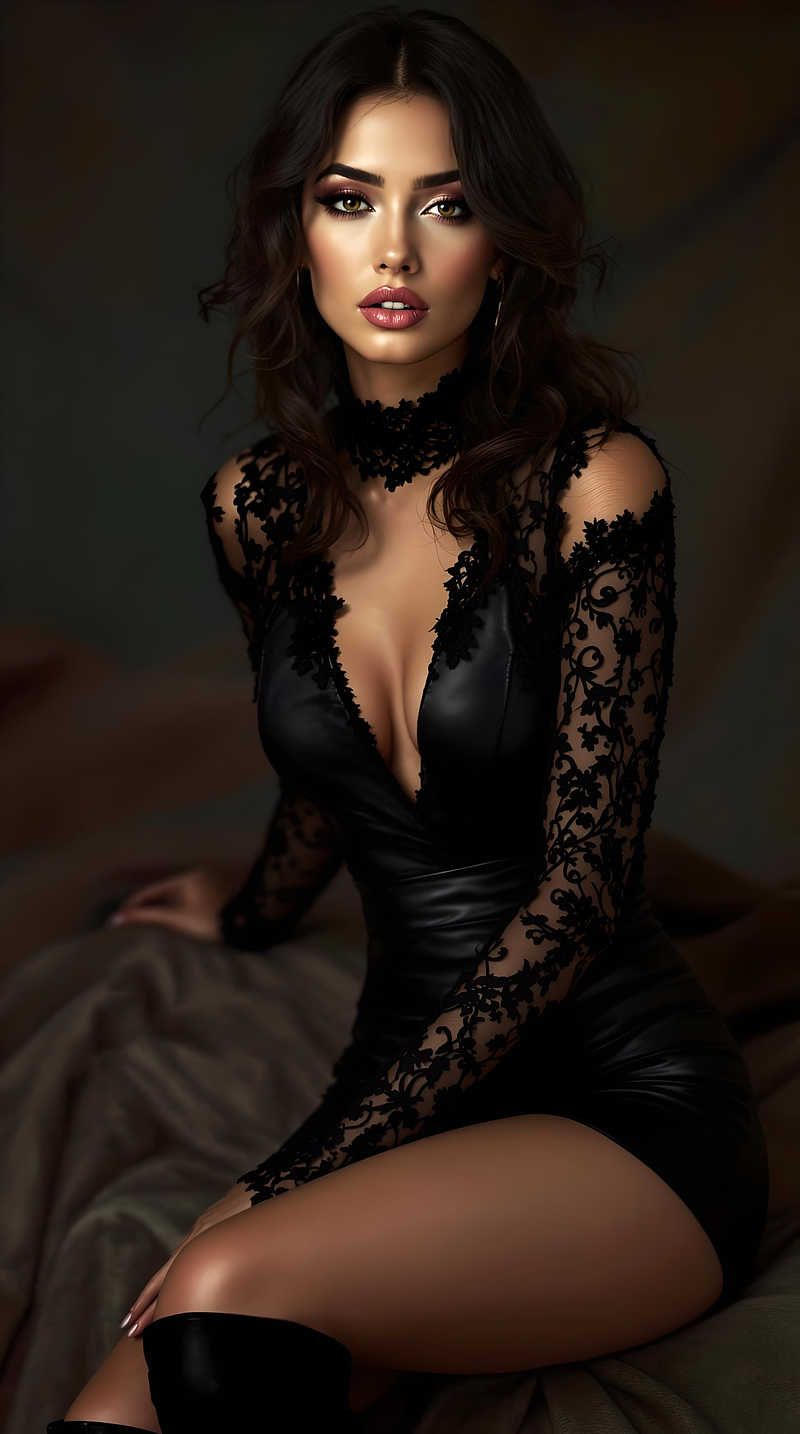

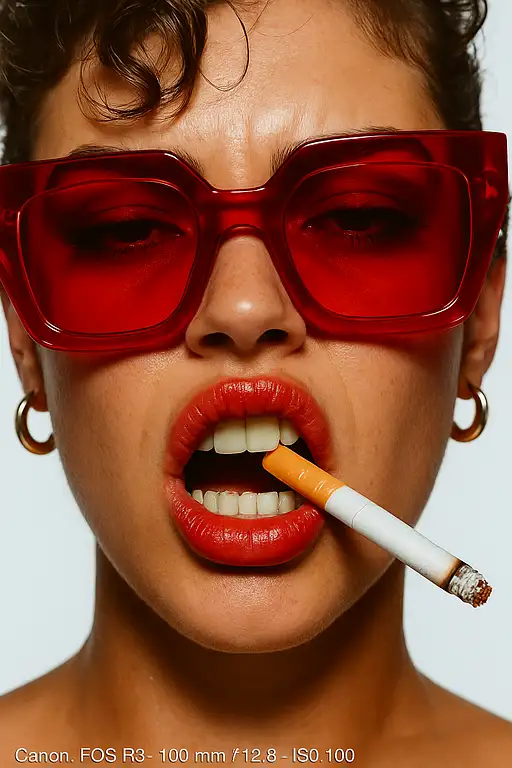
4 months ago
{ "subject": { "gender": "female", "pose": "extreme close-up of face, lips parted biting cigarette", "expression": "intense, sultry with a subtle snarl", "accessories": [ "oversized red translucent sunglasses", "gold hoop earrings", "cigarette between teeth" ], "makeup": { "lips": "glossy red lipstick", "eyes": "partially visible with eyeliner under tinted glasses", "skin": "natural with freckles and slight sheen" }, "hair": { "style": "curly strands partially falling on forehead", "color": "brown" } }, "camera": { "brand": "Canon", "model": "EOS R5", "lens": "100mm f/2.8 macro", "sensor": "Full Frame", "settings": { "shutter_speed": "1/200", "f_stop": "f/8", "iso": "100" } }, "lighting": { "type": "studio flash", "setup": "beauty dish centered above lens", "mood": "bright, high contrast", "background": "plain white" }, "style": { "aesthetic": ["Y2K editorial", "bold glam", "pop surrealism"], "color_grading": "strong reds with high saturation and contrast", "vibe": "retro rebellious fashion" }, "post_processing": { "retouching": "skin texture preserved, highlights emphasized on lips and glasses", "effects": "slight vignette, clarity enhanced" }, "output_format": "portrait" }

8 months ago
A highly detailed and hyper-realistic full-body digital illustration of a 18-year-old blonde woman with a beautiful face, a charming smile, and sleek ponytail. She has photorealistic skin texture and expressive eyes, wearing a pink, form-fitting athletic or professional outfit. The character is depicted in multiple dynamic poses: standing confidently with arms crossed, sitting gracefully on a chair, and walking forward with a purposeful stride. Consistent lighting and colors, with a focus on realistic proportions and preserving facial details. The background is a clean white studio setting with soft, even lighting that emphasizes the subject's features and textures.
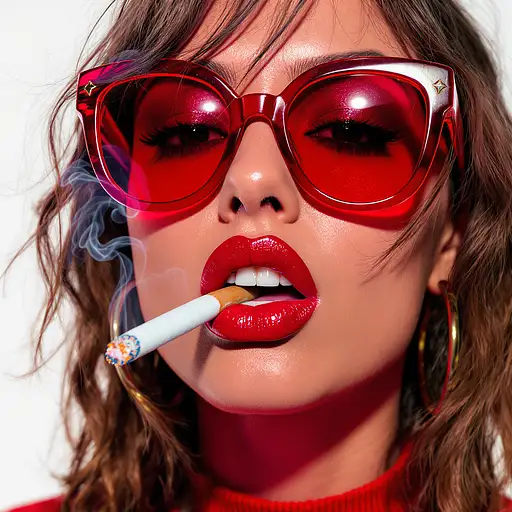
3 months ago
smoke emits from the cigarette, Capture an intense, sultry extreme close-up portrait of a female subject, focusing sharply on her face. Her lips are parted, biting a cigarette between her teeth with a subtle snarl. Subject Details: Expression: Intense, sultry, subtle snarl. Accessories: Oversized red translucent sunglasses, gold hoop earrings, cigarette between teeth. Makeup: Glossy red lipstick; eyeliner visible under the tinted glasses; natural skin with visible freckles and a slight sheen. Hair: Brown, curly strands partially falling onto the forehead. Technical Setup (Canon EOS R5): Lens: 100mm f/2.8 Macro (exploiting its close-focus capability). Settings: full Frame sensor, Shutter Speed 1/200, f/8, ISO 100. Lighting & Scene: Lighting: Studio flash with a centered beauty dish above the lens. Mood: Bright, high contrast. Background: Plain, crisp white. Style & Aesthetic: Vibe: Retro rebellious fashion. Key Styles: Y2K editorial, Bold Glam, Pop Surrealism. Color Grading: Strong, saturated reds with high overall contrast. Post-Processing: Preserve natural skin texture. Emphasize highlights on lips and glasses. Apply slight vignette and enhanced clarity. Output: Portrait orientation.
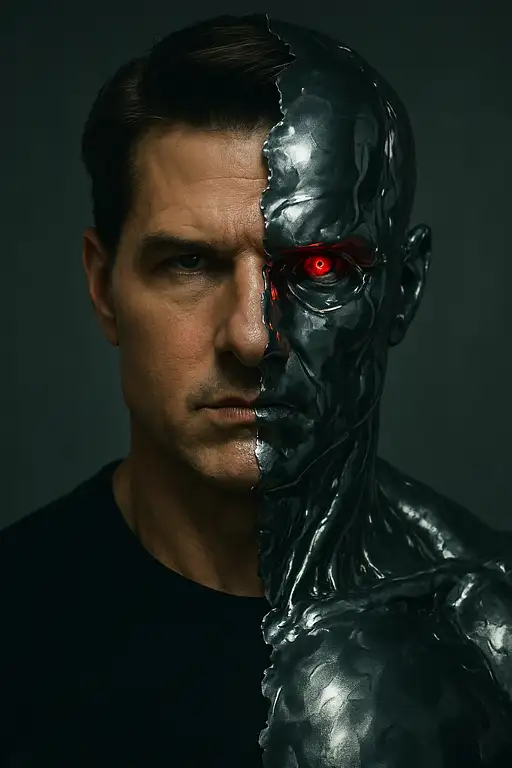
4 months ago
"subject": { "name": "Tom Cruise", "pose": "front-facing close-up", "expression": "calm, composed, intense focus, quiet menace", "symmetry": "perfectly symmetrical, face divided vertically" }, "style": { "left_half": { "visual_style": "hyper-realistic", "features": "lifelike skin textures, sharp cheekbones, piercing eyes", "lighting": "cinematic key lighting from above and side, moody shadows", "mood": "cold, authoritative, grounded in realism" }, "right_half": { "visual_style": "liquid metal, futuristic, reflective", "features": "smooth surface, chrome sheen, subtle motion effect", "inspiration": "T-1000 from Terminator 2" }, "division_line": { "style": "jagged, organic, like torn steel or cracking ice", "symbolism": "fusion of human and machine" } }, "camera": { "lens": "85mm prime", "aperture": "f/1.8", "focus": "sharp on eyes", "framing": "tight headshot with minimal headroom" }, "lighting": { "type": "dramatic, directional", "quality": "hard light on left side, metallic reflections on right", "background": "muted, minimal — soft gray gradient to isolate subject" }, "post_processing": { "skin_detail": "preserved on left half", "reflectivity": "animated glimmer or subtle motion blur on metal side", "contrast": "high contrast between organic and artificial" }, "aspect_ratio": "4:5", "moodboard_tags": [ "sci-fi portrait", "man vs machine", "Terminator T-1000", "Tom Cruise hero shot", "cinematic close-up", "hyperreal vs abstract" ]
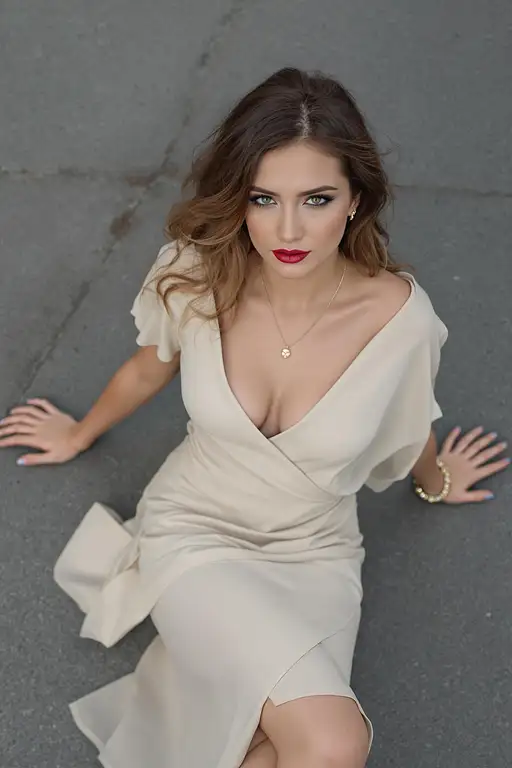
3 months ago
This is a overhead photograph of a woman sitting outdoors on what seems to be concrete pavement, wearing light beige wrap-style dress with a very low and loose neckline revealing a bit of her chest and accentuating figure, short sleeves appearing soft texture, loose waves styled hair cascading over one shoulder, light-blue eyes, dark eyeliner eyeshadow complemented red lipstick makeup, delicate necklace featuring small pendant and bracelet wrist, one hand resting near side face other arm extended outward, urban setting background muted tones possibly concrete pavement contrasting subtly against light color dress. Canon EOS 5D Mark IV camera body used to capture the image processed with Capture NX-D software for optimal color grading and tonal balance, high dynamic range emphasizing her captivating features, ISO 100 to preserve image detail in low lighting conditions, f/2.8 aperture for a shallow depth of field and creamy bokeh effect, no flash used to maintain the soft natural light of the scene, focus on her body while the surrounding environment is slightly blurred providing a subtle depth and dimensionality to the image, landscape orientation emphasizing the urban setting captured, 24-70mm f/2.8 lens capturing the details against the concrete backdrop with muted tones.

7 months ago
An Award-Winning Vogue Masterpiece, Fine Art Studio Portrait Quality: Capture Pure Realism: Visual Style: Pose: Relaxed and Unconventional Looks, Use All Ethnicities To Create portraits that embody a dream-core aesthetic, subtly softened by Rembrandt lighting to enhance the mood and depth. Setting: Capture the subject within an indoor fine art portrait photography studio, ensuring a controlled environment that elevates the quality of the image. Clothing: A Sleek Lace Blouse with a short leather mini skirt, Black over the knee high boots. Rendering Quality: Employ 5D rendering techniques to achieve studio-grade quality, ensuring precision and detail in the portrayal. Visual Integrity: Maintain a clear separation between the subject and background, eliminating any blending effects that could detract from realism. Avoid ethereal or artificial aesthetics to preserve the authenticity of the portrait. Overall Aim: The goal is to create captivating portraits that fuse fantasy elements with grounded realism, ensuring a visually stunning and cohesive final image.
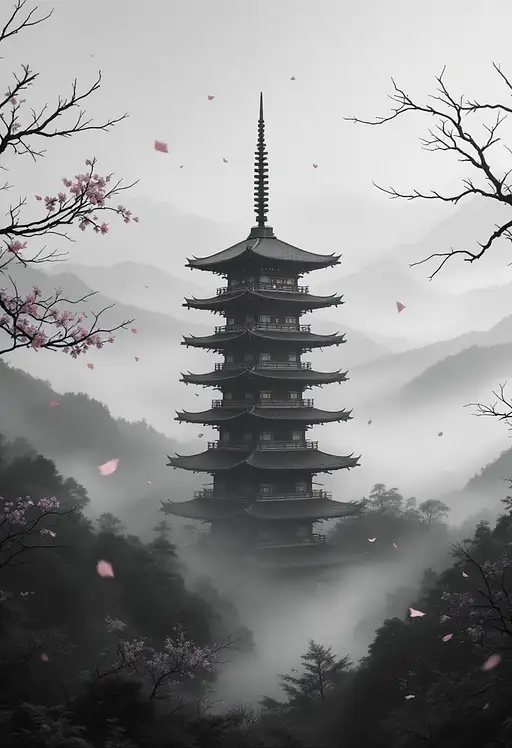
7 months ago
Traditional Japanese pagoda standing tall in a foggy mountain valley, centered mid-range view. Dense mist surrounds the base and rolls through the distant layered hills. Entire scene rendered in monochrome grayscale tones with no color grading, no blue skies. Inside the pagoda, include warm interior lighting visible through the windows on just one or two of the middle floors—soft, subtle, and realistic. This lighting should suggest quiet presence and life within, while preserving the tranquil, cinematic mood. Soft pink petals drifting in the air, extremely minimal, serving only as atmospheric accents. Bare branches subtly frame the scene on the sides—no full cherry blossom trees, and no foliage obscuring the pagoda. Moody ink-wash aesthetic, inspired by Ghost of Tsushima, cinematic yet understated. High detail in pagoda structure, gentle shadows, calm, and mysterious tone. Minimalist, peaceful composition with deep atmosphere and silence.

7 months ago
A highly detailed and hyper-realistic full-body digital illustration of a 18-year-old blonde woman with a beautiful face, a charming smile, and sleek ponytail. She has photorealistic skin texture and expressive eyes, wearing a pink, form-fitting athletic or professional outfit. The character is depicted in multiple dynamic poses: standing confidently with arms crossed, sitting gracefully on a chair, and walking forward with a purposeful stride. Consistent lighting and colors, with a focus on realistic proportions and preserving facial details. The background is a clean white studio setting with soft, even lighting that emphasizes the subject's features and textures.

9 months ago
Create an ultra-realistic UHD 4K image of Lord Shiva in an intense and dramatic scene, where he is seated on the edge of a turbulent, mystical sea. His muscular, blue-hued body radiates divine energy, and his expression is filled with pain and determination. Shiva is drinking the poisonous water from the ocean with his palms held out, his hands cupped as he gathers the dark, toxic liquid. His throat is strained as he consumes the poison, symbolizing his self-sacrifice to save the universe. The poison itself is a deep, dark blue hue, almost black, swirling around him with an ethereal, sinister glow. The water around him churns with violent waves, filled with serpents, their bodies writhing and coiling around him, adding an element of danger and mystery. The snakes’ scales glisten with a dark sheen, their eyes glowing ominously as they accompany Shiva’s sacrifice. Behind Shiva, a massive mountain looms—its jagged, craggy peaks piercing the sky. From the top of the mountain, blue-dark poison is flowing down like a volcano erupting, spewing streams of poisonous liquid that pour down into the sea below. The poison flows with terrifying force, and the sky above is filled with dark clouds, adding to the scene’s ominous and cosmic tone. The volcano-like eruption of poison seems to mirror Shiva’s internal struggle as he drinks it to protect the world. Next to Shiva, his massive trident, the Trishula, is planted firmly into the ground. The trident’s three prongs are sharp and detailed, each gleaming with divine power. It stands as a symbol of his strength and the balance of creation, preservation, and destruction. The trident’s power seems to pulse with the dark energy surrounding Shiva. Shiva’s face is a mix of agony and resolve, his third eye slightly open, reflecting the cosmic energy and his pain. His matted hair flows wildly in the poisonous wind, and his body language conveys both the immense strength required to hold the poison and the suffering he endures to protect the world. His skin has a slightly glowing blue hue, even in the midst of the darkness, symbolizing his divine essence in contrast to the poison he absorbs. The entire scene is bathed in a dark, eerie light that highlights the chaos of the surroundings, with the poison flowing through the landscape. Snow and ice might be visible on the mountain’s lower slopes, contrasting with the fiery eruption of dark poison flowing down from above. The air is thick with tension and divinity, and the atmosphere is heavy with a sense of sacrifice. Textures should be detailed: the poison’s smooth yet dangerous texture, the gleam of the snakes' scales, the intricate designs on Shiva’s body and Trishula, and the raw emotion in his facial expression. The background, with the volcano-like eruption and swirling dark waters, should be equally intricate, filled with chaotic, yet beautiful, contrast.

7 months ago
Create a breathtaking and evocative double-exposure oil painting that beautifully captures the profound bond between humanity and nature, using the iconic imagery of Gorillas in the Mist. The painting should focus on the rich emotional depth of the gorillas and the lush, mist-covered landscape of the Congo, blending these elements in a way that symbolizes both the mystery of the jungle and the majesty of these endangered creatures. The central figure of the painting should be a majestic gorilla—painted with intricate detail to reflect the animal’s strength, intelligence, and vulnerability. Its face should be filled with quiet intensity, wisdom, and an almost human-like quality, conveying its deep emotional resonance. The gorilla’s eyes should be the focal point, expressive and full of emotion, perhaps suggesting the struggle for survival, a call for preservation, or an understanding of the delicate balance between nature and human interference. The double-exposure effect should allow the environment to emerge within its form, creating a stunning fusion of the animal and its misty, green habitat. The mist itself should flow through the gorilla’s body and face, creating an ethereal atmosphere that invokes the deep, mysterious quality of the jungle. Soft, translucent layers of paint should be used to capture the wisps of fog, blending into the contours of the gorilla’s powerful form. The mist should not only symbolize the natural environment but also reflect the presence of the unseen—the unseen dangers, the spiritual connection between the gorilla and the jungle, and the ongoing battle to protect these creatures from extinction. Surrounding the gorilla, the dense, vibrant foliage of the rainforest should be depicted in rich, lush greens, with hints of deep browns and subtle touches of vibrant wildflowers. Vines, leaves, and branches can emerge from the mist, merging with the gorilla’s figure, creating the sensation that it is a part of the jungle, and vice versa. The interplay of light and shadow within the leaves and the mist should evoke a sense of both serenity and mystery, with rays of sunlight filtering through the trees, casting soft, glowing highlights on the gorilla’s fur and the surrounding vegetation. The background should suggest both the wildness and fragility of the gorilla’s environment. Darker shades of green and brown can illustrate the dense canopy, while lighter, misty shades should evoke the sense of isolation and vulnerability. In the double-exposure technique, glimpses of the jungle’s wildlife—perhaps a subtle hint of a bird or a distant silhouette of another gorilla—can appear within the mist, symbolizing the delicate interconnectedness of life within the forest ecosystem. The color palette should shift between dark and light—rich earth tones that evoke the depth and complexity of the jungle, paired with the light, airy mist that suggests hope, fragility, and the need for preservation. The mist itself should be painted with fluid brushstrokes that contrast with the more textured rendering of the gorilla, creating a sense of life and motion in both the animal and its environment. This painting should not only represent the beauty and majesty of the gorillas but also serve as a powerful call for conservation. Through the double-exposure technique, it should blur the lines between the animal and its habitat, illustrating the inseparable bond between the two and the urgent need to protect these magnificent creatures from the encroaching threats of human activity. The result should be a masterpiece that blends realism with abstraction, capturing the raw, emotional beauty of the gorillas, the mystique of their environment, and the call for preservation. The viewer should feel immersed in this tranquil yet fragile world, experiencing the emotional weight of the subject matter while marveling at the intricacy and beauty of the painting itself
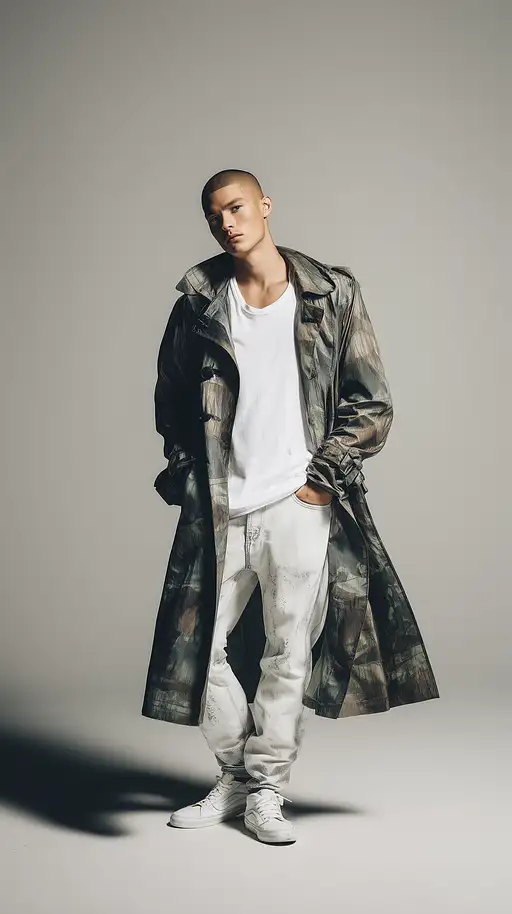
2 months ago
photography, full-body, lookbook, wearing a white T-shirt on camouflage pattern trench coat with washed jean, white Vans sneakers, rim light, solo male model, gaze, short hair, clean cutlines, neutral color temperature, subject-background distance 2m, soft lens compression 85mm, confience pose, sharp focus, gentle grain, shadow detail preserved --ar 9:16 --raw

2 months ago
{ "subject": { "gender": "female", "pose": "close-up of face, lips parted biting strawberry", "expression": "intense, sultry with a subtle snarl", "accessories": [ "oversized black translucent sunglasses", "gold hoop earrings", "strawberry between teeth" ], "makeup": { "lips": "glossy pink lipstick", "eyes": "partially visible with eyeliner under tinted glasses", "skin": "natural with freckles and slight sheen" }, "hair": { "style": "curly strands partially falling on forehead", "color": "blonde" } }, "camera": { "brand": "Canon", "model": "EOS R5", "lens": "100mm f/2.8 macro", "sensor": "Full Frame", "settings": { "shutter_speed": "1/200", "f_stop": "f/8", "iso": "100" } }, "lighting": { "type": "studio flash", "setup": "beauty dish centered above lens", "mood": "bright, high contrast", "background": "plain white" }, "style": { "aesthetic": ["Y2K editorial", "bold glam", "pop surrealism"], "color_grading": "strong reds with high saturation and contrast", "vibe": "retro rebellious fashion" }, "post_processing": { "retouching": "skin texture preserved, highlights emphasized on lips and glasses", "effects": "slight vignette, clarity enhanced" }, "output_format": "portrait" }
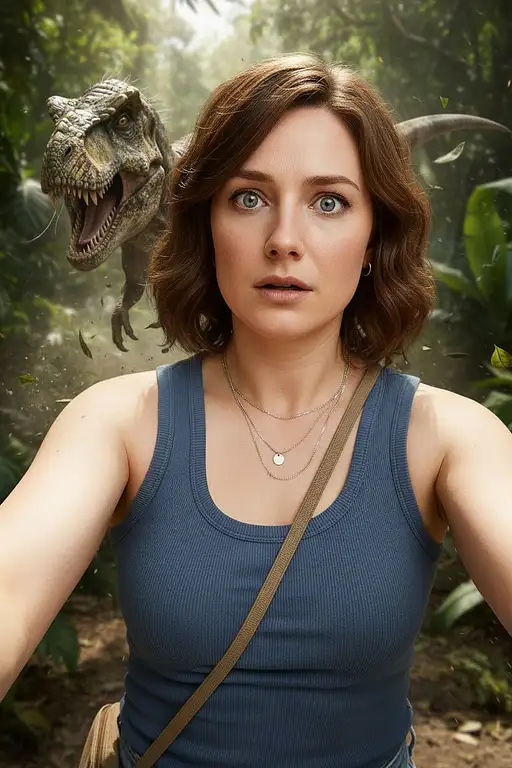
26 days ago
A hyper-credible sun-facing selfie (not a mirror shot; no phone visible) captured on an iPhone 16 Pro Max. Subject: the uploaded woman Hair: Makeup: subtle black eyeliner, matte lipstick; natural pores (no beauty filter). Expression (shocked): brows lifted and knit; eyes wide with bright catchlights; pupils slightly constricted by sun; mouth parted in a small inhale (not exaggerated); faint cheek/neck tension; micro-sheen on T-zone from heat. Wardrobe (tank top + accessories): matte ribbed cotton tank top in desaturated slate blue (no logos), scooped neckline, thick straps, relaxed fit; soft fabric micro-creases from movement, no plasticky shine. Accessories: tiny silver huggie hoops; two thin layered silver necklaces (one short box chain with a 2–3 mm disc pendant, one slightly longer cable chain); fabric-strap field watch (olive) on left wrist; woven paracord bracelet (neutral) on right wrist; a slim tan canvas cross-body strap from a small pouch just grazing the frame edge (bag itself mostly out of frame). Jewelry is low-gloss so it doesn’t flare; keep silhouettes clean and non-distracting. Moment: behind her, a realistic, predatory dinosaur (T. rex-like) leaping from foliage—low, sneaky posture; mouth slightly open with saliva filaments; cat-like focused eye; fine scales and muscular anatomy; dust/leaf debris kicked up. Lighting & look: broad noon daylight in a lush jungle (large leaves, sun shafts). Sun is the key in front of her (10–11 o’clock) for crisp, short shadows and hair rim-sparkles; use natural ground/leaf bounce as fill (key:fill ≈ 3:1) so shadows stay readable. Feather highlights—no blown hotspots on cheeks/forehead. Dynamic range preserved (retain sky/leaf detail); no obvious filters. If supported, apply background-only micro-motion blur and handheld micro-shake while keeping her face tack-sharp. Framing & optics: vertical portrait selfie at arm-length, slight wide-angle feel; background compressed enough to keep the dinosaur readable. Shallow DoF from close focus on her face—eyes ultra-sharp; controlled speculars along hair layers; distinct catchlights in eyes. Environment: humid air; faint pollen/dust motes; torn leaves mid-air; scuffed ground. Color: sunlit greens; warm, lifelike skin; dinosaur hues olive/umber/ash—not plastic. Hard rules: do not show a phone; selfie (not mirror); no stylized filters; no heavy shadows; adult subject. Avoid: plastic toy textures, CGI gloss, grim darkness, lens flares across face, exaggerated depth warping, artificial makeup blur.

5 months ago
Create a photorealistic 3D render of a floating black "A" letter geometric sculpture. The sculpture is made from a heavy, matte, porous material, resembling rough volcanic rock or textured cast iron, with clearly visible natural irregularities, pits, and a sandpaper-like surface quality. The material has no gloss—fully matte—but catches soft light at high angles, enhancing bumpiness. The object is an asymmetrical, visually confusing interlocked structure composed of thick angular slabs and sharp planes intersecting in impossible Escher-like ways. Key geometric features include: There’s a subtle engraving of the number “1” on the upper right side, flush with the surface, not colored or contrasted—just a soft indent visible under light. The background is a clean, flat light cream-beige gradient, completely smooth, noise-free. The sculpture is floating in mid-air, without a stand or platform. A soft, diffuse shadow below it on the ground plane reinforces the illusion of levitation. The lighting setup is studio-style, soft and non-directional, coming from above and slightly front-left. It’s evenly illuminating the form, revealing surface imperfections without harsh shadows. Lighting should feel realistic and neutral—no dramatic rim lights, no bloom or glare. The camera angle is slightly above and rotated about 20–30 degrees to the left, creating a dynamic diagonal composition. Depth of field should be very shallow or none at all—entire object in sharp focus. Avoid clean CAD-like shading or polygonal smoothness—preserve roughness, uneven light dispersion, and edge imperfections. The final aesthetic should feel like a real-world, modernist stone sculpture photographed in a minimal studio.

8 months ago
A highly detailed and hyper-realistic full-body digital illustration of a 18-year-old blonde woman with a beautiful face, a charming smile, and sleek ponytail. She has photorealistic skin texture and expressive eyes, wearing a pink, form-fitting athletic or professional outfit. The character is depicted in multiple dynamic poses: standing confidently with arms crossed, sitting gracefully on a chair, and walking forward with a purposeful stride. Consistent lighting and colors, with a focus on realistic proportions and preserving facial details. The background is a clean white studio setting with soft, even lighting that emphasizes the subject's features and textures. resolution photography interior design, dreamy sunken living room conversation pit, wooden floor, small windows opening onto the garden, bauhaus furniture and decoration, high ceiling, beige blue salmon pastel palette, interior design magazine, cozy atmosphere; 8k, intricate detail, photorealistic, realistic light, wide angle, kinkfolk photography, A+D architecture

6 months ago
A highly detailed and hyper-realistic full-body digital illustration of a 18-year-old blonde woman with a beautiful face, a charming smile, and sleek ponytail. She has photorealistic skin texture and expressive eyes, wearing a pink, form-fitting athletic or professional outfit. The character is depicted in multiple dynamic poses: standing confidently with arms crossed, sitting gracefully on a chair, and walking forward with a purposeful stride. Consistent lighting and colors, with a focus on realistic proportions and preserving facial details. The background is a clean white studio setting with soft, even lighting that emphasizes the subject's features and textures.
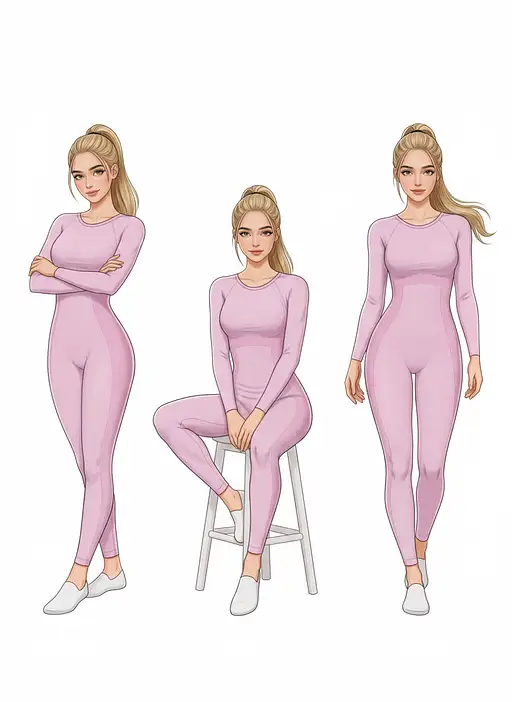
2 months ago
A highly detailed and hyper-realistic full-body digital illustration of a 18-year-old blonde woman with a beautiful face, a charming smile, and sleek ponytail. She has photorealistic skin texture and expressive eyes, wearing a pink, form-fitting athletic or professional outfit. The character is depicted in multiple dynamic poses: standing confidently with arms crossed, sitting gracefully on a chair, and walking forward with a purposeful stride. Consistent lighting and colors, with a focus on realistic proportions and preserving facial details. The background is a clean white studio setting with soft, even lighting that emphasizes the subject's features and textures.
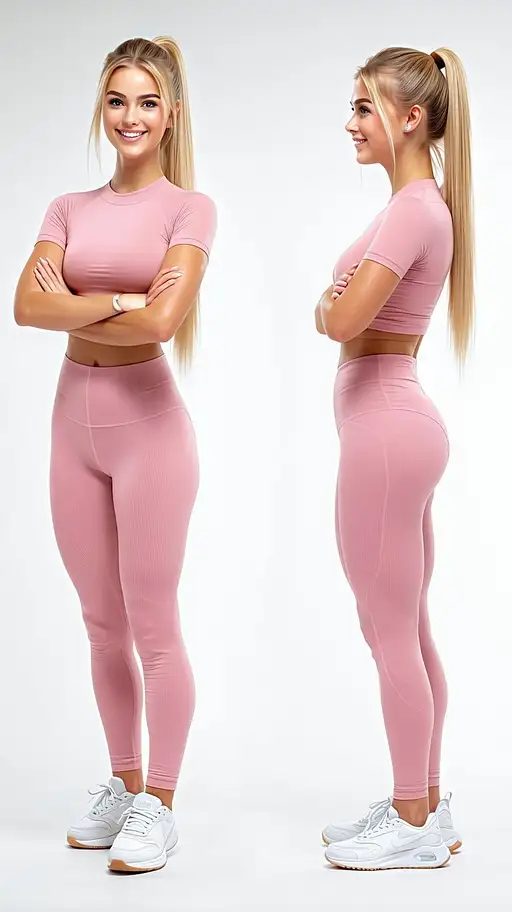
2 months ago
A highly detailed and hyper-realistic full-body digital illustration of a 18-year-old blonde woman with a beautiful face, a charming smile, and sleek ponytail. She has photorealistic skin texture and expressive eyes, wearing a pink, form-fitting athletic or professional outfit. The character is depicted in multiple dynamic poses: standing confidently with arms crossed, sitting gracefully on a chair, and walking forward with a purposeful stride. Consistent lighting and colors, with a focus on realistic proportions and preserving facial details. The background is a clean white studio setting with soft, even lighting that emphasizes the subject's features and textures.

6 months ago
A highly detailed and hyper-realistic full-body digital illustration of a 18-year-old blonde woman with a beautiful face, a charming smile, and sleek ponytail. She has photorealistic skin texture and expressive eyes, wearing a pink, form-fitting athletic or professional outfit. The character is depicted in multiple dynamic poses: standing confidently with arms crossed, sitting gracefully on a chair, and walking forward with a purposeful stride. Consistent lighting and colors, with a focus on realistic proportions and preserving facial details. The background is a clean white studio setting with soft, even lighting that emphasizes the subject's features and textures.
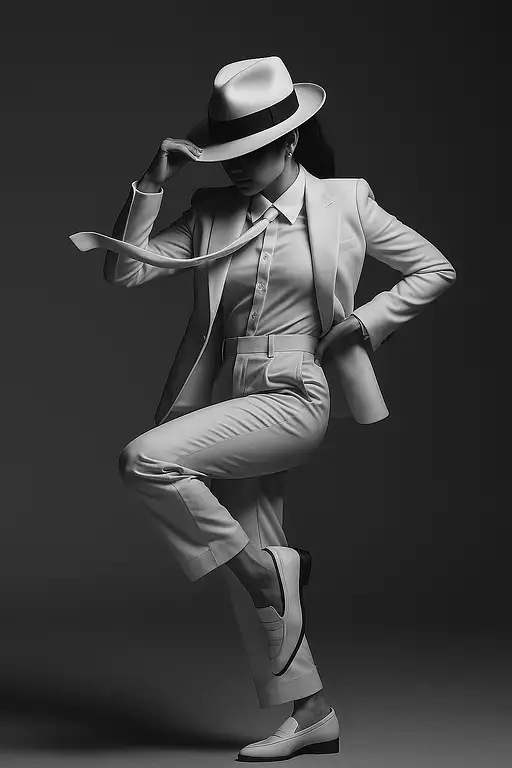
2 months ago
Photorealistic black-and-white studio portrait, full-body female dancer in an all-white look: white tailored suit (jacket + trousers) with white blouse, white fedora tilted to shade the eyes (face partly in shadow), white slim tie streaming to the left; right hand on brim, left arm bent back. Dynamic mid-move pose: right knee lifted and crossing, left heel raised with toe touching the floor, body forming an elegant S-curve. White loafers with white socks visible. Mid-gray seamless background for separation; key light from upper-right + subtle rim from left; add gentle negative fill to carve edges; high contrast with preserved highlight detail (no clipping), clean floor shadow, no props. Ultra-sharp fabric micro-texture and suit folds visible. Center framing, wide negative space. 85mm, f/5.6, 1/1000s, ISO 200, studio strobes, freeze-motion, RAW, 8K, ultra-sharp.

7 months ago
The chaotic energy of the city swirled around her, a symphony of muted grays and browns. Pedestrians blurred into streaks of motion, their forms barely decipherable in the shallow depth of field. Yet, amidst this urban haze, she stood, a vibrant splash of color against the subdued backdrop. Captured with the iconic imperfections of a Lomography lens, a subtle vignette framed her presence, the edges softening as if the city itself was holding its breath. Her intricate details – the delicate lace of her dress, the glint of light in her eyes, the subtle curve of her lips – were rendered with surprising clarity in the sharp focus, drawing the eye straight to her beauty. Behind her, the bokeh danced, a kaleidoscope of unfocused lights and shapes, a visual representation of the bustling street's frenetic pace, all fading into a creamy, ethereal blur. She was the sole beacon of color and focus, a fleeting moment of beauty perfectly preserved amidst the city's relentless pulse. --chaos

8 days ago
Generate a hyper-realistic, cinematic 8k image of the uploaded man with his face fully preserved. he is wearing sleek black sunglasses and a sharp black tailored suit, walking confidently on a red carpet in a natural motion. his hands are in his pockets, exuding calm authority and celebrity vibes. surrounding him are excited fans and glamorous women reaching out to touch him, while journalists’ cameras flash from below the frame, adding intense energy and drama. a luxury lamborghini is parked right beside the red carpet, enhancing the high-status atmosphere. the setting should feel crowded, dense, and cinematic, with rich lighting, dramatic shadows, and the color grading of a high-end sony a7s4 camera shot. aspect ratio 9:16 for vertical cinematic framing.
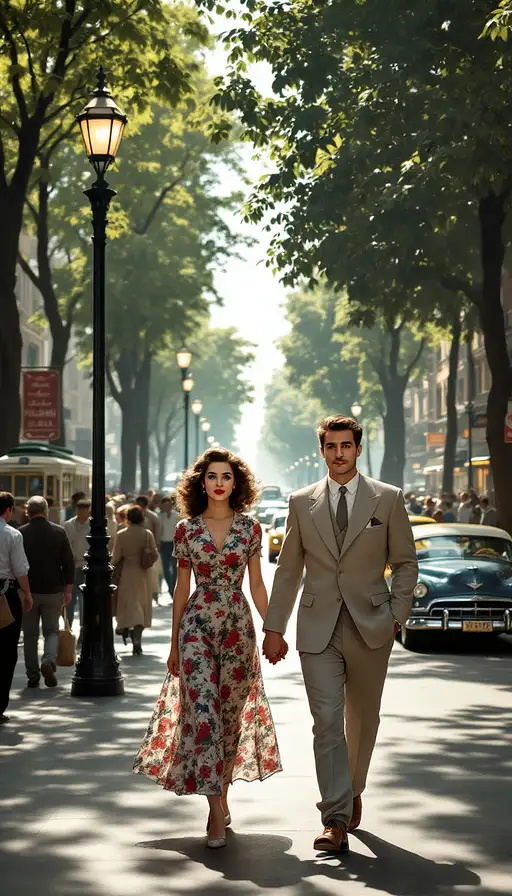
7 months ago
a young couple from the 1950s walking along the vibrant and busy streets of Vali Asr Street (formerly Pahlavi Street) in Tehran. The scene is set in the heart of the city, with the distinct architecture and atmosphere of the time. The girl, with voluminous, curly hair, cat-eye eyeliner, and red lipstick, wears a floral patterned dress with a wide collar and a flared skirt typical of the 1950s. The boy, with neatly styled hair and a thin mustache, wears a light-colored wide-collared suit with a shirt and thin tie. The couple walks hand in hand, surrounded by bustling pedestrians. The wide, tree-lined street is lined with tall, green plane trees, casting dappled shadows on the sidewalk. Vintage streetlamps illuminate the pathway, while classic Persian storefronts, with signs written in traditional fonts, line the street. Old cars from the era drive by, including taxis, and a few trams can be seen passing in the background. The atmosphere is lively, with sounds of city life and the hustle of pedestrians. Sunlight filters through the trees, casting a golden glow over the scene, evoking the warm and nostalgic charm of 1950s Tehran. The iconic tall plane trees frame the scene, and the towering buildings of the time stand proudly in the distance, preserving the historic elegance of the era.
